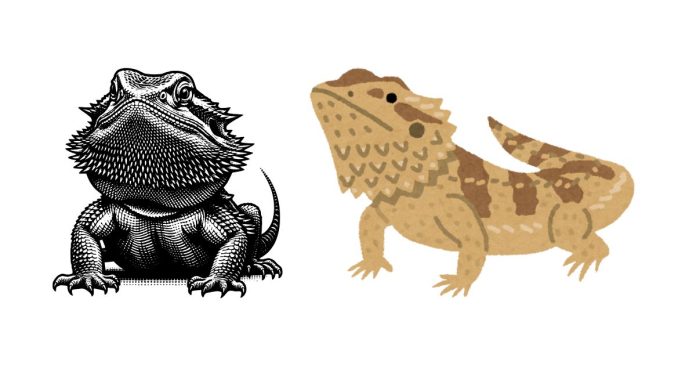If you’re considering adopting a bearded dragon or simply curious about these fascinating reptiles, you might be wondering: What do fully grown bearded dragons look like? Bearded dragons, known for their distinctive appearance and calm nature, are one of the most popular pet reptiles. But what do they look like once they reach full size? In this blog post, we’ll take a closer look at the physical characteristics of fully grown bearded dragons, including their size, color, and unique features that make them stand out.
Size: How Big Do Bearded Dragons Get?
One of the most noticeable traits of a fully grown bearded dragon is its size. Bearded dragons are considered medium-sized reptiles, and they grow significantly over time. Here’s what you can expect in terms of size:
- Length: Fully grown bearded dragons typically measure between 18 to 24 inches (46 to 61 cm) in length from head to tail. Some may even reach up to 26 inches (66 cm), but this is less common. The tail accounts for about half of the dragon’s total length, making them long and somewhat slender creatures.
- Weight: An adult bearded dragon usually weighs between 300 to 500 grams (around 0.66 to 1.1 pounds). This can vary depending on their diet and living conditions, but they generally have a solid, muscular build.
Coloration: What Colors Do Fully Grown Bearded Dragons Have?
Fully grown bearded dragons come in a variety of colors and patterns, and their coloration can change depending on their mood, temperature, and environment. The natural colors and the range of hues they can display are what make them so captivating:
- Basic Colors: Bearded dragons are typically tan, brown, or gray in color. Their natural camouflage helps them blend in with their desert environments in the wild.
- Color Variations: Many bearded dragons in captivity have been selectively bred to show a range of vibrant colors, including red, orange, yellow, and white. Some can even have blue or purple hues, although these are rarer and usually a result of breeding programs.
- Beard: One of the most distinctive features of a bearded dragon is its “beard”—a spiky, flap of skin that can turn black when the dragon is threatened, stressed, or trying to assert dominance. The beard gives them their name and is especially noticeable when they puff it out.
Head and Body: Unique Features of a Fully Grown Bearded Dragon
When fully grown, bearded dragons are easily recognizable by their unique body shape and head structure:
- Head: They have a triangular head with a flat top, and their eyes are usually bright and expressive. The beard is located under their chin and is a feature that can be puffed out dramatically during displays of aggression or mating.
- Body Shape: Bearded dragons have a stocky, muscular body, with rough, spiny scales covering most of their skin. These scales give them a rugged appearance and help protect them in their natural habitat.
- Tail: The tail is long and tapering, often covered with spiny scales. Bearded dragons can lose their tails in the wild as a defense mechanism, but in captivity, they typically maintain their tails throughout their lives.
Behavior and Posture: What Do Fully Grown Bearded Dragons Act Like?
Fully grown bearded dragons are generally calm and social creatures, which makes them great pets. Their behavior can also change based on their mood and environment:
- Posture: A fully grown bearded dragon may rest in a basking position, with its body extended flat against a surface to absorb heat. When they feel safe or curious, they often stand up on their hind legs for a more upright stance, giving them a unique, almost “alert” posture.
- Mood Changes: When a bearded dragon feels threatened or is in a defensive stance, it will puff out its beard and may even change color to darker shades of black or brown. They can also wave their arms as a sign of submission or to indicate that they are not a threat.
- Social Behavior: Bearded dragons are known for their sociable nature. While they can be territorial with other males, they generally enjoy the company of humans and can often be seen basking with their owners or following them around.
Care Considerations for Fully Grown Bearded Dragons
To ensure your bearded dragon reaches its full size and remains healthy, proper care is essential. Here are some care tips:
- Enclosure: Bearded dragons need a large enclosure with plenty of space to move around. A 40-gallon tank is ideal for an adult bearded dragon. The enclosure should include a basking spot, UVB lighting, and areas for climbing and hiding.
- Diet: A balanced diet is crucial for their growth. Bearded dragons are omnivores and require a mix of insects (like crickets or mealworms) and vegetables (such as leafy greens, squash, and bell peppers) to stay healthy.
- Temperatures: Bearded dragons thrive in a warm environment. Their enclosure should have a basking spot around 95–105°F (35–40°C) and a cooler area that’s around 75–85°F (24–29°C).
The Distinctive Look of a Fully Grown Bearded Dragon
Fully grown bearded dragons are captivating creatures with a unique appearance. Their stocky build, vibrant color variations, spiny scales, and distinctive beard make them stand out among other reptiles. As one of the most beloved pet reptiles, they offer a calm and interactive companion for reptile enthusiasts. By providing proper care, these fascinating creatures can thrive and continue to captivate their owners with their playful personalities and striking appearance.


